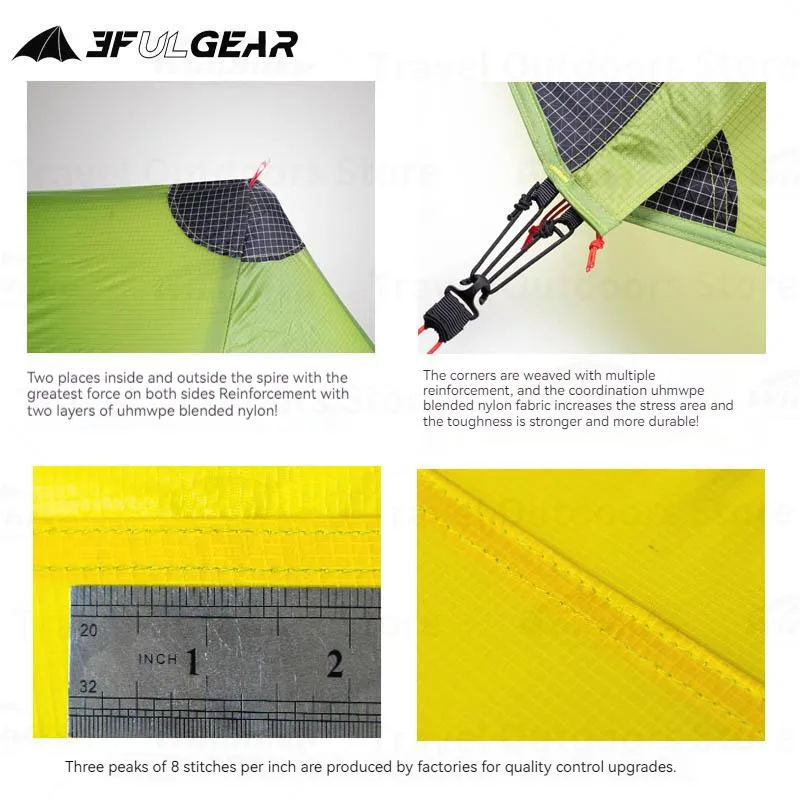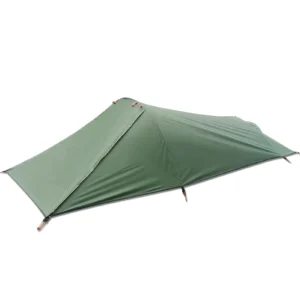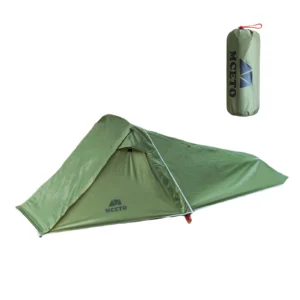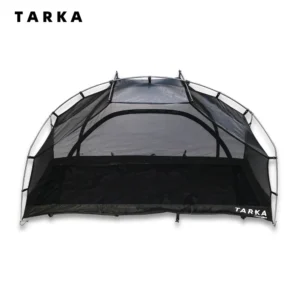Introduction: Your Home for Thousands of Miles
When embarking on a thru-hike spanning hundreds or thousands of miles, your shelter becomes more than just equipment—it’s your home. In the world of long-distance hiking, “ultralight” isn’t just a marketing term; it’s a crucial design philosophy typically meaning solo shelters under 2.5 pounds (1.1 kg). This weight classification makes a substantial difference when carrying your home on your back day after day.
Shelter selection can make or break a thru-hiking experience. With daily mileage often ranging from 15-25 miles (24-40 km), the cumulative effect of carrying extra ounces becomes significant. Every half-pound of unnecessary weight translates to hundreds of additional pounds carried over a complete thru-hike. Understanding different shelter options for two campers becomes crucial when planning extended trips with a partner.
Beyond simple weight considerations, your shelter must balance durability, weather protection, ease of setup, and livability—all while remaining as light as possible. Many hikers new to ultralight lightweight tents don’t realize that intelligent feature selection can dramatically improve both comfort and hiking efficiency, without adding significant weight.
In this guide, we’ll examine the essential features that define quality ultralight shelters for thru-hiking, helping you understand what matters most when your tent becomes your home for months on trail.
Weight: The Foundation of Ultralight Shelter Selection
Weight is the cornerstone consideration for any thru-hiking shelter. Ultralight tents specifically designed for long-distance trails typically fall into strict weight categories:
- Solo tents: Under 2 pounds/0.9 kg (ultralight), 2-3 pounds/0.9-1.4 kg (lightweight)
- Two-person tents: Under 3 pounds/1.4 kg (ultralight), 3-4 pounds/1.4-1.8 kg (lightweight)
Understanding the difference between “packed weight” and “trail weight” helps clarify what you’ll actually carry. Packed weight includes everything: tent body, rainfly, poles, stakes, stuff sacks, and guylines. Trail weight typically includes just the minimum needed for setup: tent body, rainfly, and poles.
The impact of tent weight on physical endurance cannot be overstated. Calculating the cumulative weight carried over a 2,000+ mile (3,220+ km) thru-hike reveals that each extra ounce translates to carrying an additional 7-8 pounds (3.2-3.6 kg) over the entire journey. Many hikers discover that understanding how heavy a hiking tent should be dramatically changes their shelter selection priorities.
Component weight breakdown is equally important:
* Tent body: Typically 30-40% of total weight
* Rainfly: Usually 25-35% of total weight
* Poles: Often 20-30% of total weight
* Stakes/guylines: About 10-15% of total weight
Strategic weight considerations should factor in your trail conditions and personal capacity. For example, desert sections might prioritize sun protection while forested areas might allow for lighter rain protection. Understanding how tent weight impacts hiking endurance helps you make informed decisions about where to save weight and where to accept additional ounces for needed features.
Material Science: The Technology Behind Ultralight Performance
Modern ultralight tents achieve their remarkable weight savings through advanced materials that offer exceptional strength-to-weight ratios. These fabrics determine not just weight, but also durability, packed size, and weather resistance.
Dyneema Composite Fabric (DCF, formerly known as Cuben Fiber) represents the premium option in ultralight shelters. This non-woven fabric features Dyneema fibers sandwiched between polyester films, creating material that’s waterproof without additional coating, incredibly lightweight, and won’t stretch or sag when wet. However, DCF comes with significant cost premiums—often doubling or tripling tent prices—and can be less abrasion-resistant than other options.
Silnylon (silicone-impregnated nylon) remains the most common ultralight tent material, offering excellent strength and reasonable weight. Its main drawback is stretch when wet, potentially requiring readjustment during rainy conditions. Silpoly (silicone-impregnated polyester) addresses this issue with minimal stretch when wet, though it’s typically slightly heavier than silnylon.
More budget-friendly polyurethane-coated (PU-coated) fabrics provide adequate waterproofing at higher weights, making them common in entry-level lightweight tents.
Understanding technical specifications helps evaluate quality:
* Denier (D): Measures thread thickness; lower numbers mean lighter fabric (7-20D for rainfly, 15-30D for floors)
* Hydrostatic head: Water pressure resistance measured in millimeters (1,500+ mm for floors, 1,200+ mm for rainfly)
* Tear strength: Resistance to ripping, particularly important for ultralight fabrics
Material care significantly impacts longevity. UV exposure degrades all fabrics but particularly affects silicone-treated materials. Proper drying before storage prevents mildew, while gentle cleaning maintains water resistance. Selecting a tent from our ultralight backpacking tent collection means getting materials specifically chosen for their performance in challenging conditions.
Wall Construction: Single vs. Double-Wall Design
The decision between single-wall and double-wall construction represents one of the most significant design differences in ultralight tents, each offering distinct advantages for thru-hiking.
Single-wall tents combine the rainfly and tent body into one integrated unit. This design:
* Reduces weight by eliminating materials (typically 8-16 oz/227-454 g lighter than comparable double-wall models)
* Simplifies and speeds up setup, especially valuable in bad weather
* Maximizes interior space efficiency
* Generally costs less due to simpler construction
However, single-wall designs struggle with condensation management, as the single barrier between you and the elements collects moisture from your breath and body heat, potentially dripping onto gear. They also often provide less ventilation, making them stuffier in hot weather.
Double-wall tents feature separate inner tent (typically mesh and lightweight fabric) and rainfly components:
* Superior condensation management with moisture collecting on rainfly rather than interior
* Better temperature regulation through adjustable ventilation
* More versatile setup options (rainfly only, inner only, or both)
* Often more comfortable in humid environments

Hybrid designs incorporate elements of both approaches, with partial solid inner walls and strategic mesh placement to balance weight savings with condensation control.
Climate considerations should strongly influence your choice. Single-wall designs excel in dry, cold environments like high-altitude mountains, while double-wall constructions perform better in humid conditions common on trails like the Appalachian Trail. For ultralight options utilizing specialized designs, exploring our ultralight trekking pole tent collection provides excellent examples of how manufacturers balance these considerations.
Support Structure: Freestanding vs. Non-Freestanding Options
The support structure of your ultralight tent directly impacts weight, setup complexity, and adaptability to various terrain—all critical factors on a thru-hike.
Trekking pole tents represent the ultimate weight-saving approach. These non-freestanding shelters use your hiking poles for structural support rather than carrying dedicated tent poles, saving 8-12 oz (227-340 g) on average. This design requires proper tensioning through stakes and guylines, creating a learning curve for perfect pitching. Understanding the freestanding tent structure helps appreciate why many experienced hikers prefer this weight-saving alternative.
Semi-freestanding designs incorporate some dedicated pole structure but still require staking for complete setup. This compromise offers greater stability than purely non-freestanding shelters while saving some weight compared to fully freestanding options.
Fully freestanding tents stand independently using integrated pole structures without requiring stakes (though staking is always recommended for stability). Benefits include:
* Easier setup on challenging surfaces like rock, sand, or platforms
* Simpler learning curve and faster setup
* Ability to easily move the pitched tent to find optimal positioning
Site selection becomes especially important with non-freestanding designs, which require suitable ground for secure staking. Mastering two-person lightweight tent setup techniques proves particularly valuable when pitching space is limited or ground conditions are challenging.
Stake and guyline selection deserves careful attention. Aluminum stakes offer the best strength-to-weight ratio for most conditions, while titanium provides premium durability at higher cost. Carrying extra guylines enables adaptation to varied conditions, creating a more storm-worthy pitch when needed.
Livability: Essential Comfort Features for Long-Term Use
While weight often dominates ultralight gear discussions, livability features determine your daily comfort during months on trail. Thoughtful design elements can provide substantial quality-of-life improvements with minimal weight penalties.
Interior dimensions form the foundation of shelter comfort. For solo hikers, floor dimensions of at least 84-88” × 25-30” (213-224 cm × 64-76 cm) provide adequate sleeping space, while a peak height of 40-48” (102-122 cm) allows for comfortable sitting. When hiking with a partner, choosing the ultimate compact shelter for two becomes an exercise in balancing weight against adequate space.
Door configurations significantly impact convenience and ventilation. Two-door designs eliminate the need to climb over your partner for midnight bathroom breaks, while also creating cross-ventilation. Single-door designs save weight but sacrifice convenience in two-person shelters.
Vestibules provide critical protected storage space for gear. Thru-hikers typically need 8-10 square feet (0.74-0.93 sq m) of vestibule space to store packs, shoes, and wet gear outside the sleeping area. Our backpacking tent vestibule options showcase how these spaces can be optimized without excessive weight.
Ventilation systems fundamentally impact comfort through condensation management. Look for:
* Adjustable vents that can remain open during light rain
* Strategic mesh placement for airflow
* Rainfly design that promotes air circulation
* Door positioning that creates cross-ventilation
Internal organization features like pockets, loops, and gear lofts help maintain order in your small space. Well-designed pockets keep essentials accessible during the night, while ceiling loops allow for hanging lights or drying small items.
Weather Protection: Durability Against the Elements
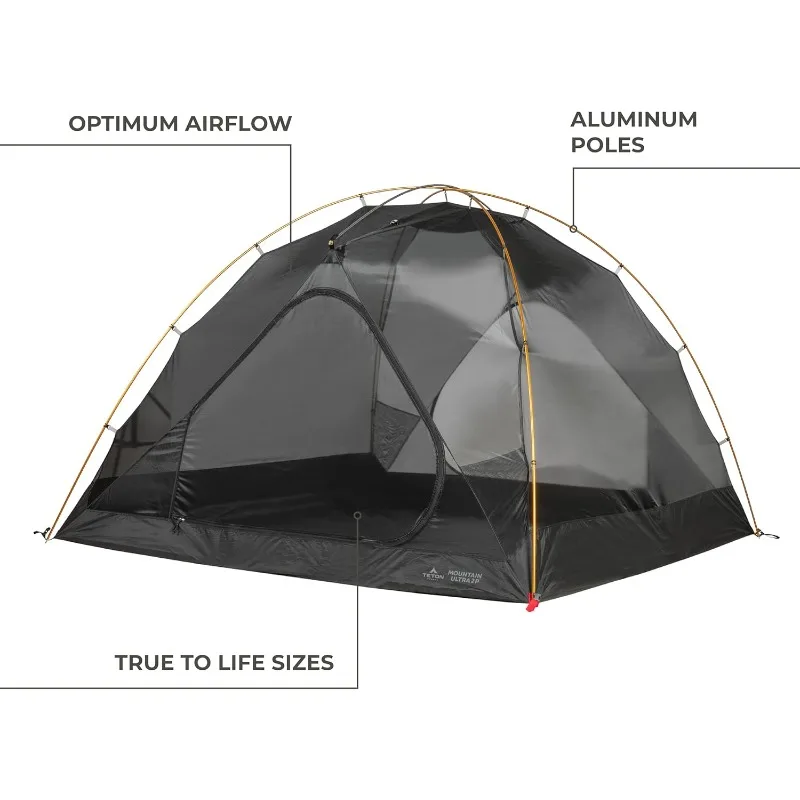
Thru-hikes subject shelters to months of continuous weather exposure across varied conditions, making weather protection capabilities critical for both comfort and gear longevity.
Waterproofing systems involve multiple components working together:
* Seam sealing prevents water entry at fabric junctions
* Hydrostatic head ratings indicate water pressure resistance
* Bathtub floor design elevates seams above ground level to prevent splashback infiltration
* Door designs that channel water away from the interior
Wind stability features determine performance during storms, especially important when camping above treeline or during shoulder seasons. Key elements include:
* Pole structure design and material strength
* Adequate guyout points (6-8 minimum for storm-worthy pitching)
* Aerodynamic shape to shed wind
* Proper tensioning capability for stability
Our waterproof backpacking tent collection specifically addresses these weather protection priorities without unnecessary weight.
Insect protection becomes particularly important in humid environments and during bug seasons. Look for no-see-um mesh that balances airflow with protection from the smallest biting insects. Door closures should create complete seals without gaps that allow entry.
Durability at high-stress points requires reinforcement to prevent failures during extended use. Critical areas include:
* Stake loops and guyout points
* Pole insertion points
* Door zippers and tensions points
* Floor corners and high-abrasion zones
Regular maintenance significantly extends weather protection performance. Cleaning dirt from zippers prevents failures, while periodic reapplication of DWR (Durable Water Repellent) treatment maintains fabric water resistance.
Practicality Features: Trail Life Considerations
Lightweight Backpacking Tent, Ultralight Backpacking Tent, Ultralight Bivy Tent
Ultralight Single Person Camping Tent with Aluminum Poles for 3-Season Backpacking Waterproof DesignPrice range: $94.88 through $326.82 Select options This product has multiple variants. The options may be chosen on the product pageLightweight Backpacking Tent, Ultralight Backpacking Tent, Waterproof Backpacking Tent
$391.05 Select options This product has multiple variants. The options may be chosen on the product pageUltralight Backpacking Tent, Ultralight Dome Tent, Winter Camping Tent
Price range: $369.63 through $370.07 Select options This product has multiple variants. The options may be chosen on the product pageBackpacking Tent with Vestibule, Freestanding Backpacking Tent, Lightweight Backpacking Tent
Price range: $446.89 through $447.22 Select options This product has multiple variants. The options may be chosen on the product pageBackpacking Tent with Vestibule, Trekking Pole Backpacking Tent, Waterproof Camping Tent
Price range: $271.99 through $519.52 Select options This product has multiple variants. The options may be chosen on the product pageUltralight Backpacking Tent, Ultralight Trekking Pole Tent
Price range: $350.87 through $351.98 Select options This product has multiple variants. The options may be chosen on the product page
Daily trail life involves practical considerations beyond specifications. These usage realities significantly impact your shelter satisfaction over thousands of miles.
Packed size directly affects how your tent fits in your backpack. Ultralight tents typically pack to cylinders about 12-16” × 4-6” (30-41 cm × 10-15 cm), but compression techniques make a substantial difference. Mastering tent packing tips helps optimize space usage in your pack, keeping essential items accessible throughout the day.
Setup and takedown efficiency becomes critical when you’re exhausted or facing approaching storms. Well-designed tents can be pitched in under 2 minutes in normal conditions, while complicated designs might take 5+ minutes. Practice before your thru-hike develops muscle memory that pays dividends throughout your journey.
Adaptability to varied terrain addresses a reality of thru-hiking: you won’t always find perfect tent sites. Features supporting adaptability include:
* Adjustable guylines for uneven ground
* Flexible pole configurations for awkward spaces
* Freestanding capability for platforms or rocky ground
* Modular components for setup flexibility
Footprint considerations impact both weight and durability. While manufacturer footprints provide perfect fits, alternatives like Tyvek (1.5-2 oz/ft²) or Polycro plastic (0.5 oz/ft²) offer significant weight savings while still protecting your tent floor.
Color selection affects stealth camping options, heat absorption, and even mood. Muted greens and browns blend with surroundings for low visibility, while brighter colors make finding your tent easier in crowded campgrounds and can improve spirits during dreary weather.
Critical Trade-Offs: Balancing Competing Priorities
Ultralight tent selection ultimately involves navigating unavoidable trade-offs. Understanding these competing priorities helps make informed decisions aligned with your personal hiking style.
Weight versus durability presents the fundamental ultralight compromise. Each reduction in fabric weight typically corresponds to decreased abrasion resistance and puncture strength. Understanding what makes lightweight tent trekking designs effective helps evaluate where material limitations might become problematic.
Weight versus comfort/space requires honest assessment of your personal thresholds. A tent saving 8 ounces but causing poor sleep due to cramped dimensions ultimately hinders hiking performance more than carrying those extra ounces.
Weight versus cost represents perhaps the most challenging trade-off. Premium ultralight materials often add $100-$300 to comparable tent designs, with diminishing weight returns as price increases. The lightest options frequently cost 2-3 times more than slightly heavier alternatives.
Weather protection versus ventilation requires constant balancing. Features that seal out storms also trap moisture inside, while ventilation features create potential water entry points during severe weather.
Freestanding convenience versus trekking pole weight savings presents a clear choice between setup simplicity and weight reduction. This decision should consider your overall pack weight strategy and campsite expectations.
Setup simplicity versus adaptability to difficult terrain affects daily satisfaction. Simpler designs pitch faster but may struggle on suboptimal ground, while more complex systems adapt better to varied conditions but require more time and expertise.
Matching Features to Your Thru-Hike
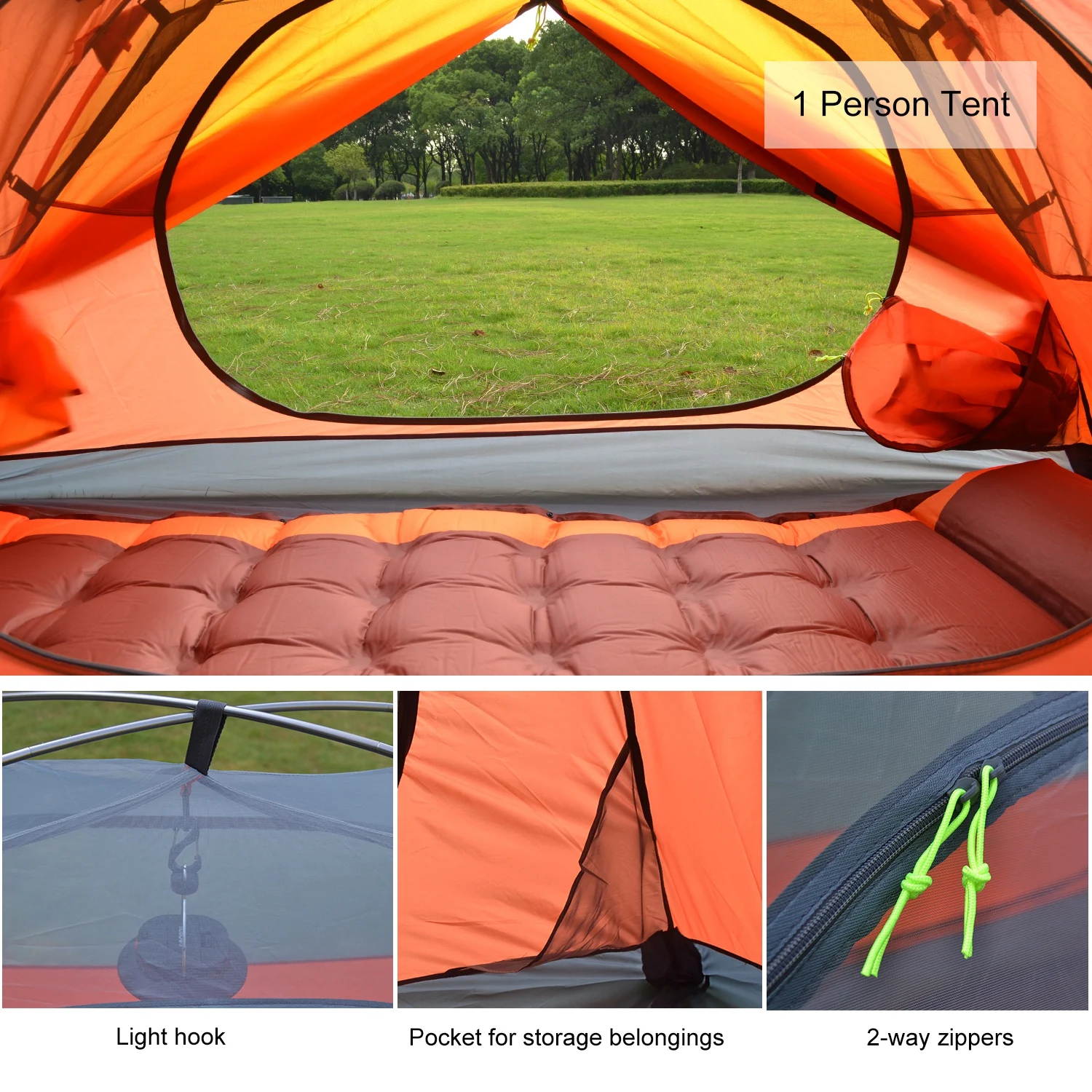
Every thru-hike presents unique challenges, making personalized shelter selection crucial for success. Consider these trail-specific and personal factors when evaluating tent features.
Solo versus partner hiking fundamentally changes shelter requirements. While is a 2-person tent actually big enough becomes a legitimate question for many hikers, sharing a tent can save substantial weight per person despite the overall heavier shelter. Two one-person tents typically weigh 30-40% more combined than one two-person tent.
Trail-specific environmental factors should heavily influence your decision:
* Appalachian Trail: High humidity suggests double-wall designs with excellent ventilation
* Pacific Crest Trail: Varied conditions favor adaptable designs that handle both desert and alpine environments
* Continental Divide Trail: Exposed terrain and potential severe weather call for robust wind stability
* Desert trails: Prioritize sun protection and ventilation over extensive rain protection
* Tropical routes: Maximum ventilation and insect protection become essential
Campsite availability varies dramatically between trails. Those with established campgrounds might prioritize freestanding designs, while trails requiring dispersed camping benefit from adaptable non-freestanding options that work in irregular spaces.
Personal preference evaluation honestly addresses your priorities:
* Sleep quality needs (width, length, headroom requirements)
* Claustrophobia considerations (wall angles, interior volume)
* Organization preferences (pockets, gear storage requirements)
* Setup patience threshold (complexity tolerance when tired)
When to prioritize other features over weight largely depends on personal comfort thresholds and trip-specific needs. Extra ounces for features that significantly improve your experience (like a second door or larger vestibule) often prove worthwhile investments in overall hiking enjoyment.
Supplementary Content: Is a Tent Always Necessary?
While tents represent the most common thru-hiking shelter, alternative options sometimes offer better weight-to-comfort ratios depending on your hiking style and trail conditions.
Hammock systems excel in forested environments with reliable hanging options. Complete hammock setups (including rain protection and insulation) typically weigh 1.5-3 pounds (0.7-1.4 kg). Benefits include superior comfort on sloped or rocky ground and excellent ventilation, though they struggle in treeless environments and require additional insulation underneath in cool conditions.
Tarp and bivy combinations create minimalist shelters weighing as little as 12-20 ounces (340-570 g) combined. This approach offers excellent weather adaptability with proper pitching skills but sacrifices insect protection unless using a bivy with mesh. Our ultralight bivy tent options showcase modern designs that balance minimal weight with adequate protection.
Cowboy camping—sleeping without overhead shelter—represents the ultimate ultralight approach. This technique works best in dry climates with predictable weather and low insect pressure. Many thru-hikers carry minimal shelter as backup while cowboy camping when conditions permit.
These alternatives typically require greater outdoor skills and weather judgment than traditional tents, making them better suited to experienced backpackers comfortable assessing environmental risks.
Supplementary Content: Tent Maintenance on Long Trails
Maintaining your shelter over thousands of miles requires specific practices to prevent premature failure. Small daily efforts significantly extend your tent’s lifespan.
Field repair essentials should include:
* Tenacious Tape for fabric tears (lighter and more effective than duct tape)
* Spare guyline for replacements or additional tie-outs
* Silicone sealant for seam repairs
* Spare stakes to replace lost or bent ones
Daily maintenance practices prevent cumulative damage:
* Brush off dirt before packing to prevent abrasion
* Allow morning condensation to dry when possible before packing
* Handle zippers gently, using two hands to reduce stress
* Properly tension guylines to prevent fabric strain
During consecutive rainy days, use rest breaks to partially dry tents by turning them inside out under pack covers or in vestibules. On zero days, prioritize completely drying your shelter before repacking, using laundromat dryers on no/low heat if necessary.
Supplementary Content: When Is a Heavier Tent Worth It?
While ultralight principles generally favor the lightest viable option, specific scenarios justify additional ounces for enhanced features.
Extreme weather expectations may warrant heavier, more robust shelter designs. When facing potential snow loads, sustained high winds, or extended heavy precipitation, the additional 8-16 ounces (227-454 g) of a stronger tent provide crucial protection.
Significant shared weight with a partner changes the weight calculation. When two hikers share a tent, even a “heavy” 4-pound (1.8 kg) shelter equals just 2 pounds (0.9 kg) per person—potentially lighter than individual ultralight options while providing more space.
Particular personal needs might justify additional weight. Larger hikers, those with claustrophobia, or individuals with mobility limitations may find that slightly heavier designs with more interior space dramatically improve sleep quality and overall hiking experience.
Specific trail conditions sometimes necessitate feature-rich shelters. Platform-focused camping areas benefit from freestanding designs, while regions with aggressive local wildlife might prioritize more substantial fabrics and robust closures.
In the end, the best ultralight tent for thru-hiking balances minimal weight with the specific features that support your hiking style, physical needs, and chosen trail. At Explore Elements, we understand that the perfect shelter creates the foundation for successful long-distance hiking adventures.

